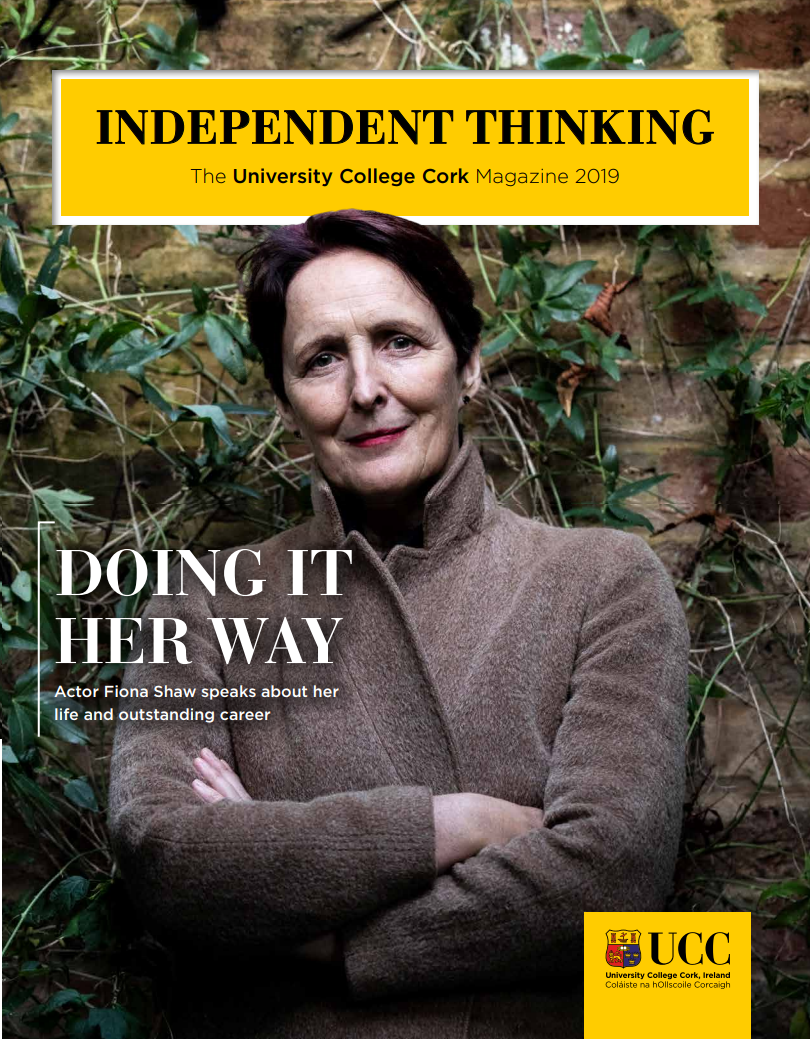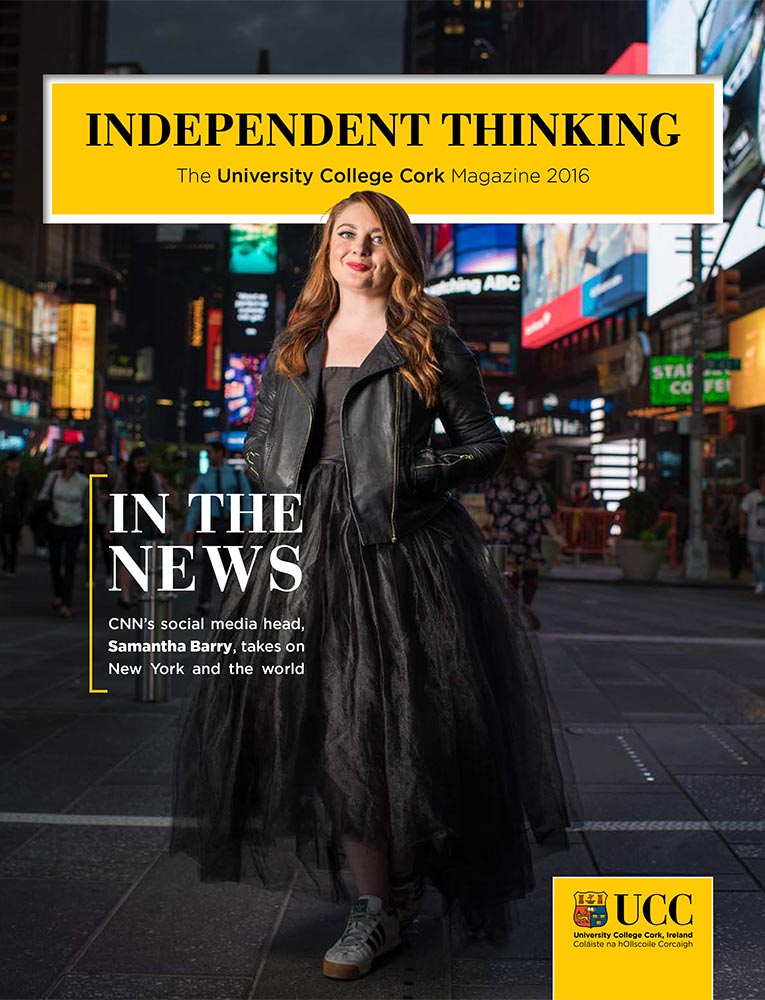Features
- UCC Springboard+: Kieran Egan
- UCC’s new Hub serves as ‘one-stop-shop’ service for 26,000 students
- Interview: Ryan Tubridy chats politics, history and his love of the arts on UCC visit
- UCC Emergency Care Society gets hands-on with life-saving skills
- Fitzgibbon Cup glory for UCC as hurlers beat IT Carlow in thrilling final
- GatewayUCC bridging the gap for research-entrepreneurs
- Pocket-sized brain injury monitor could be a game-changer for infant health
- Future of Irish hockey in safe hands with rising star Hannah
- Dr Eithne Hunt: Healthy habits for body and mind
- From Architecture to Web Development
- Nine APC Microbiome researchers make prestigious ‘highly cited’ list
- UCC honours five exceptional alumni at annual awards ceremony
- UCC spotlights four of its brightest up-and-coming female career scientists
- Rich Ferrie leads an exciting new era for UCC Innovation
- UCC honours its graduates with the official naming of the Alumni Bridge
- New UCC series explains how university research impacts daily life
- UCC's rising sports stars presented with scholarships
- UCC ranked among top universities in Europe for teaching excellence
Times Higher Education Europe Teaching Rankings 2019
- UCC makes Green Flag history…again!
The first university in the world to be awarded a fourth Green Flag
- Blazing a trail
Professor Helen Whelton charts her path to success, from curious dentistry student to global award-winner
- A Summer’s Evening on the Quad hits the right note for Cork charities
The fundraising event is now in its 14th year
- A curious mind
Paul Ross on his love of science, his greatest moments of discovery, and the exciting next chapter at APC Microbiome Ireland
- Mind your microbiome: 9 ways to boost your gut health
In honour of World Microbiome Day
- UCC hosts top wind energy experts at Cork’s largest ever conference
Scientists and engineers gathered to discuss the future of renewable energy
- Lord David Puttnam makes a passionate case for careers in the arts
He features in the latest episode of UCC’s podcast, Plain Speaking
- Funding announced for UCC SFI Research Centres
- Beekeeping makes life sweeter for Cork kids
- Saving Ireland's seals with GPS
- UCC celebrates a stellar year in sport
- Tommy Fleming headlines A Summer's Evening on the Quad
Tickets available now
- UCC ranked as global leader for sustainable social and economic impact
Times Higher Education University Impact Rankings
- Former UCC President Michael Murphy becomes first ever Irish President of EUA
Professor Murphy served as UCC President for 10 years
- MaREI researcher returns from epic adventure in search of blue whales
Dr Ailbhe Kavanagh spent seven weeks in Antarctica
- Doireann Ní Ghríofa among six new members elected to Aosdána at UCC ceremony
Writer Doireann is a UCC alumna
- Former White House drug advisor goes 'inside America’s opioid crisis'
Keith Humphreys is the latest guest on UCC's official podcast, Plain Speaking
- UCC launches Sports Strategy
Pride on our chest, belief in our heart, sport in our bones.
- How Nicole Ryan is powering change after tragedy
Alex’s Adventure
- Brainwave ‘donation’ research offers promise for dementia treatment
Research and innovation
- Full-circle for Paul as UCC extends partnership with Cork City FC
A perfect match
- Praise for The Irish Revolution as 'Atlas' documentary airs on RTÉ
Atlas of the Irish Revolution
- Pastures new
UCC launches its Food Institute
- Making waves at MaREI
Ireland's National Ocean Test Facility opens
- Research spotlight: APC Microbiome Ireland
10 researchers among Highly Cited
- Spin-out success
Atlantia Food Clinical Trials expanding stateside
- Billy Morgan: Pride of Cork
Marking a decade of UCC Sigerson Cup football
- The future is bright for soccer's Captain Fantastic
Ciara McNamara
- The next phase for rugby's rising star
Jack O'Sullivan
- RTÉ to air 'Atlas' documentary
The next step for the Atlas of the Irish Revolution
- Top business talent share their secrets to success
CUBS Conference 2019
- Green roots and flying boots: Cork Chamber project showcases ‘future’ of Cork
Future Forms is part of Cork Chamber’s 200th anniversary celebrations
- CEO and camogie star Mary O'Connor is leading change for women in sport
Moving the goalposts
- Mary Robinson is the first guest on UCC’s new podcast
Plain Speaking is now available to stream
MaREI researcher returns from epic adventure in search of blue whales
Dr Ailbhe Kavanagh braved icebergs and sub-zero temperatures to spend seven weeks on a research expedition to the Antarctic, in search of the blue whale. She shares her extraordinary experience with Jane Haynes
.jpg)
“I thought it would be a once-in-a-lifetime experience, but I already want to go again!”
We’re not surprised that Dr Ailbhe Kavanagh is lamenting the end of her research trip to Antarctica, as part of the most comprehensive scientific voyage* ever undertaken to study the blue whale and its food source, krill.
A postdoctoral researcher in Marine Ecology at MaREI, the SFI Research Centre for Marine and Renewable Energy, marine biologist Ailbhe was one of 28 scientists chosen to participate in the seven-week expedition, which set sail in January.
“The trip was this multi-disciplinary team effort, to answer questions on the interactions between blue whales and krill,” explains Ailbhe.
“The southern ocean is an important habitat for many marine species, including marine mammals, who rely either directly or indirectly on phytoplankton.
“Increased solar radiation from global warming and the hole in the ozone layer is reducing phytoplankton, which could have knock-on effects up the food chain.”
"I thought it would be a once-in-a-lifetime experience, but I already want to go again!" - Dr Ailbhe Kavanagh
This comes into play particularly in the case of krill, small crustaceans which serve as the primary food source for several of the southern ocean’s marine animals, including the blue whale.
“Antarctic blue whales are critically endangered. The population is still less than one per cent of what of what it was, pre-whaling. These are the largest animals to ever have lived on Earth. They’re endangered, and their food source is in danger,” says Ailbhe.
“We were also doing water chemistry research, looking at how blue whales may contribute to the nutrient cycle in the southern ocean. It’s not just that they eat krill, but they possibly also contribute to the entire food cycle.”
Ailbhe – who worked on a large project involving humpback whales in Australia, for her PhD – is no stranger to setting sail in the name of research. And while a seven-week trip to the Antarctic – where they were ‘five or six days from a hospital’ – served up new challenges, the team was equipped with ‘amazing’ facilities, expertise and technologies.
Thanks to the impressive methods employed by the passive acousticians aboard the boat, Ailbhe and the team were able to find more than 30 blue whales.
“Acousticians were deploying sonobuoys into the water as we travelled, using the sounds the blue whales make – which travel for hundreds of kilometres – to triangulate their positions,” she explains.
“They would send us on a bearing towards a blue whale, or sometimes if they had multiple buoys in the water at the same time, they could almost pinpoint how far away the whales were.”
It was this technology which led to one of the most unforgettable moments of the trip for Ailbhe: when the boat sailed into the middle of a huge feeding aggregation of whales.
“There must have been 100 whales, all within four or five kilometres of us. And then, we found one blue whale in the middle of it!” she recalls.
Seeing her first blue whale was an ‘incredible’ experience for Ailbhe, whose research took her very close to the enormous mammals.
.JPG)
“When we were video-tracking, we kept the whales at a distance of about a kilometre and tracked them with video as they surfaced,” she explains.
“Then, we went in for photo identification, where you had to get within a couple of hundred metres to get a picture of the side of the whale’s body. We also had a couple of very close, accidental approaches, where the boat was stationary and the whales just happened to swim past.”
Of course, not every day spent in Antarctica was memorable for its exciting discoveries. Indeed, acclimatising to the weather was one of the tougher aspects of the trip.
“We had the full spectrum of weather,” Ailbhe recalls. “There was one night where it was really rough, and my belongings and I slid across the room. I think, because I knew how far from everything we were, it was a little scary.”
"I’ve climbed Carrantuohill, I’ve been out in snow when it’s ‘freezing’ – this a different kind of freezing!" - Dr Ailbhe Kavanagh
The cold was another beast to contend with.
“I’ve climbed Carrantuohill, I’ve been out in snow when it’s ‘freezing’ – this a different kind of freezing!” she says.
“One day, the weather looked nice so we were outside working. The thermometer said it was -10°C but, with the wind chill, it was -26 or something crazy. It’s like needles on your skin, and there’s not one bit of you exposed – you’re wearing so many layers, balaclavas, sunglasses.”
It’s safe to say though, that braving the conditions was worth it.
“We had amazing experiences,” says Ailbhe, recalling the day she watched two fin whales swim around the boat for half-an-hour, and watching drone footage of a blue whale calf playing with its mother.
.JPG)
Of course, being among a research group composed of two-thirds females was also a highlight for Ailbhe: “I have never been on a trip with so many women, and that was amazing.”
Based purely on the research, the expedition seems to have been a success, with the team currently processing the reams of information gathered: photo identification, drone footage, blow samples, water samples, over 700 hours of passive acoustics.
“I think everybody did amazingly to get everything, and I think there will be some really nice papers to come from it in the next year or two,” says Ailbhe.
You can find out more about research at MaREI through this link.
*As part of the Australian Antarctic Program, the research is managed through the Science Branch of the Australian Antarctic Division and supported by a grant of sea time on RV Investigator from the CSIRO Marine National Facility. A large number of collaborating institutions and partners were involved in supporting this voyage including University of Tasmania, Murdoch University, University of Technology Sydney, University of Washington, University of Liverpool, Texas A&M University, University College Cork and the World Wildlife Fund.



